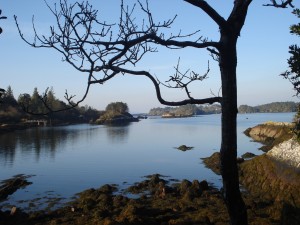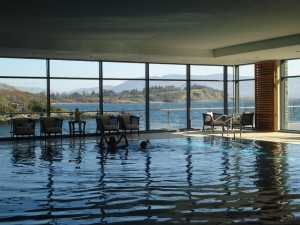
The recession has forced many of our golden gates of tourism to open to new ideas and new visitors, indirectly creating a more responsible and accessible form of tourism. I recently visited the five star hotels of Parknasilla in Kerry and Castlemartyr in Cork which have opened their doors to us mere mortals. This is not the work of Nama either, but a company called Natural Retreats (www.naturalretreats.com) which already owns sustainable (and sumptuous) houses in the UK and has, for the last year, been moving into self-catering lodges in the grounds of Ireland’s most exclusive hotels, making them just a little more inclusive.
I wrote about this company when it first entered the Irish market , impressed by their ethos of developing sustainable tourism in areas of important cultural and natural heritage. Recently, I checked out how they were doing. First stop, Parknasilla, where we thought we might have to go through a separate interlopers’ entrance so that ‘battered old Volvo’ alarms didn’t go off. But the integration of posh and pleb was done seamlessly and without judgement. We checked in at the same desk as golfers with their Golfs, and Foxrockers with their furs, as they headed to their suites, and we to our self-catering.

However, it was the outdoors which beckoned at Parknasilla, and is the reason why people have been coming since 1895. There are five hundred acres of woodland and coastal walks here, with tiny islands linked to the hotel by wooden bridges. On an early morning stroll to catch the mist coming up over the many inlets, there was an eerie silence with only the oyster catchers on dawn duty. The beauty here is truly mesmeric.
Guests staying at Natural Retreats’ lodges are given full access to hotel facilities, sharing hot tubs, croquet lawns and extraordinarily beautiful swimming pools with the great washed. The Victorian ‘children should be seen and not heard’ still hovers a little at Parknasilla, being asked to leave the pool at 5pm, only served dinner at certain times, and a general air of hushed tones around the lounges. The games room is in a separate building and equipment was on last legs. But when the pool shut we just ran down to the Victorian bathing huts on the shore and dived into the Atlantic, letting our screams echo around the bay, hushed tones long forgotten. The hotel restaurant was beyond our budget anyway, so we ate in from the nearby butchers or out at O’Shea’s pub, with its fab fish pie. Both in nearby Sneem.
At Castlemartyr, the ambience was very different. Although equally luxurious, it had a younger feel to it, with bikes for everyone’s use, the kids were allowed to walk the hotel’s dogs and blind eyes were turned when ‘adult time’ kicked in at the pool when it was quiet. The games room is ‘soooo cool’ with leather sofas, a Wii, snooker table with all the balls and board games with all the bits. We cycled into the village for supplies, picnicked on the lawns and noone blinked an eye.
One disappointment, however, was the welcome hampers which had impressed me so much at Natural Retreats in
Yorkshire, brimming with local produce. Here they were more white sliced loaf and instant coffee. Natural Retreats’ Director, Ewan Kearney reassured me, “We’re working through an ongoing list of improvements at each site, including implementing local produce in the welcome hampers, improving the guest information manuals with things to do and see in the local area, eco-friendly cleaning products and see this as a gradual process that is more likely to succeed if the business is financially stable”.
These are not cheap breaks by any means, but as George Bernard Shaw said of Parknasilla, “This place does not belong to any world that you or I have ever worked in or lived in. It is part of our dream world”. Natural Retreats has brought the dream a bit closer to reality for many and, with sustainability at its core, aims to make the same possible for future generations to come.
This article, by Catherine Mack, was first published in The Irish Times 28 August 2010
.
